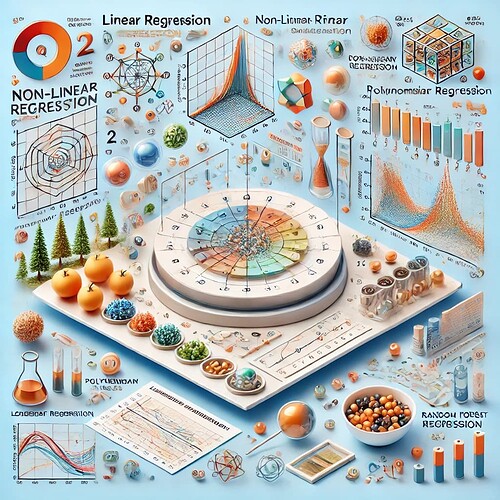- Introduction
The quantification of NMR signal responses is critical for ensuring measurement accuracy and reproducibility in quantitative nuclear magnetic resonance (qNMR). The Q-matrix formulation, given by:
defines the steady-state efficiency of the signal response as a function of the relaxation delay (D1), longitudinal relaxation time (T1), and flip angle (θ). While this model provides an analytical description of Q, experimental observations often deviate due to instrument variations, sample-dependent relaxation effects, and other external factors.
To improve the predictive accuracy of Q for untested D1 values, this study compares:
- Linear Regression Methods
- Process Simulation & Uncertainty (PSU)
- Non-Linear Regression Methods
- Polynomial Regression
- Random Forest Regression
- Gaussian Process Regression (GPR)
Through this analysis, we evaluate which method best generalizes Q values for untested D1 conditions, particularly at D1/T1 = 2 and D1/T1 = 3 , respectively.
- Methodology
2.1 Experimental Data and Initial Model
The dataset consists of three known Q values:
- D1/T1 = 1 → Q = 63.21
- D1/T1 = 4 → Q = 98.17
- D1/T1 = 7 → Q = 99.909
We compare both linear and non-linear regression methods to assess their predictive performance.
- Results and Discussion
3.1 Linear vs. Non-Linear Regression Methods
We first compare Bayesian Optimization (GPR-based) and PSU to evaluate the effectiveness of linear vs. non-linear models.
| Method | Q (D1/T1 = 3) | Q (D1/T1 = 2) |
|---|---|---|
| GPR | 88.66 ± 0.08 | 79.57 ± 0.11 |
| PSU | 80.98 ± 13.56 | 73.07 ± 13.56 |
Since the relationship between D1/T1 and Q is inherently non-linear, a linear approach like PSU struggles to capture trends effectively, especially for extrapolated values. PSU, based on linear regression, shows high sensitivity to data points, leading to a significantly higher uncertainty (±13.56). Linear Regression (PSU) Was Insufficient. Because PSU is inherently a linear model, meaning it is highly sensitive to data points, and lacks the flexibility to adapt to the non-linear relationship between Q and D1/T1. In addition, a linear model fails to generalize to larger D1/T1 values, it results in high uncertainty (±13.56). Accordingly, PSU’s extrapolation is unreliable due to the assumption of linearity.
Whereas, since the Q-matrix equation itself suggests an exponential dependency on D1/T1, non-linear regression methods are inherently more suited for prediction. For example, GPR, which incorporates non-linearity, provides a lower uncertainty (±0.08 for D1/T1=3). In practice, more non-linear regression method can be evaluated for further optimization:
- Polynomial Regression: Captures trends but overfits at high D1.
- Random Forest: Handles data noise well but lacks smooth extrapolation.
- GPR: Provides smooth predictions with uncertainty estimation.
- Physics-Informed GPR (Best Model): Incorporates theoretical knowledge and corrects systematic deviations.
3.2 Non-Linear Regression Methods
Using the four regression methods, we computed the following Q estimates:
| Method | Q (D1/T1 = 3) | Q (D1/T1 = 2) |
|---|---|---|
| Polynomial Regression | 90.21 | 82.19 |
| Random Forest Regression | 88.10 | 73.07 |
| Gaussian Process Regression (GPR) | 88.66 ± 0.08 | 79.57 ± 0.11 |
3.3 Accuracy and Generalization Analysis
To assess the generalization ability of each method, we validated the predictions at D1/T1 = 2 and D1/T1 = 3, where the known true values are:
- Q_true (D1/T1 = 2) = 86.47
- Q_true (D1/T1 = 3) = 95.02
Polynomial Regression provided better predicted values.
- Conclusion
The results indicate that non-linear regression methods fit the Q-Matrix Predictions. Future research should extend this approach to larger datasets or explore other non-linear regression methods. The objective is to conduct 3 tests and then a proper qNMR parameter, D1 can be predicted with ideal accuracy level.
(Special thanks to ChatGTP, providing all necessary information and assistance in the computation.)
Image was created by ChatGPT
Continuing the discussion from qNMR platform Method & Perspectives:
